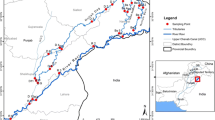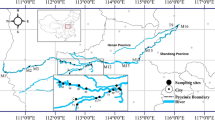Abstract
Polychlorinated biphenyls (PCBs) are chemicals that have become ubiquitous environmental pollutants due to their past use, persistence, and long-range transport thus requiring continuous monitoring. Therefore, this research was carried out to investigate spatial and temporal trends of seven indicator PCBs and two others (PCB 105 and PCB 156) in the Nairobi River. Levels of PCBs ranged from below detection limit (bdl) to 157.64 ± 1.52 ng g−1 and bdl to 718.78 ± 1.71 ng L−1 for sediment and water, respectively. PCBs 28, 138, and 153 were the most dominant contributing 33.4%, 17.9%, and 14.5% to the total PCBs in sediments and 54.6%, 19.3%, and 14.1% to the total PCBs in water. There was a general increase in ΣPCBs from 18.89 to 151.18 ng g−1 for sediments and 275.52 to 429.84 ng L−1 for water as the River flowed downstream. The dry season recorded the highest ΣPCB in sediments while the rainy season recorded the highest ΣPCBs in water, with levels exceeding the WHO water quality guidelines. Risk assessment revealed that populations living downstream are exposed to high levels of PCBs through the consumption of water. Levels of ΣPCBs downstream also exceeded the sediment quality guidelines meaning that aquatic organisms are threatened.



Similar content being viewed by others
References
Adeyinka, G. C., Moodley, B., Birungi, G., & Ndungu, P. (2018). Quantitative analyses of selected polychlorinated biphenyl (PCB) congeners in water, soil, and sediment during winter and spring seasons from Msunduzi River, South Africa. Environmental Monitoring and Assessment, 190, 621–634. https://doi.org/10.1007/s10661-018-6993-8.
Arnich, N., Tard, A., Leblanc, J. C., Le Bizec, B., Narbonne, J. F., & Maximilien, R. (2009). Dietary intake of non-dioxin-like PCBs (NDL-PCBs) in France, impact of maximum levels in some foodstuffs. Regulatory Toxicology and Pharmacology, 54, 287–293. https://doi.org/10.1016/j.yrtph.2009.05.010.
IARC. (1987). Overall evaluations of carcinogenicity: an updating of IARC monographs volumes 1 to 42. http://monographs.iarc.fr/ENG/Monographs/suppl7/. Accessed 19 August 2020.
ATSDR. (2000). Toxicological profile for polychlorinated biphenyls (PCBs). Atlanta, GA: U.S. Department of Health and Human Services, Public Health Service. https://www.atsdr.cdc.gov/toxprofiles/tp.asp?id=142&tid=26. Accessed 15 January 2020.
Breivik, K., Sweetman, A., Pacyna, J. M., & Jones, K. C. (2007). Towards a global historical emission inventory for selected PCB congeners — a mass balance approach 1. Global production and consumption. Science of the Total Environment, 290, 181–198.
Carpenter, D. O. (2006). Polychlorinated biphenyls (PCBs): routes of exposure and effects on human health. Reviews on Environmental Health, 21, 1–23. https://doi.org/10.1515/reveh.2006.21.1.1.
Cui, X., Dong, J., Huang, Z., Liu, C., Qiao, X., Wang, X., Zhao, X., Zheng, B., & Shen, J. (2020). Polychlorinated biphenyls in the drinking water source of the Yangtze River: characteristics and risk assessment. Environmental Sciences Europe, 32, 29–38. https://doi.org/10.1186/s12302-020-00309-6.
Dirbaba, N. B., Li, S., Wu, H., Yan, X., & Wang, J. (2018). Organochlorine pesticides, polybrominated diphenyl ethers and polychlorinated biphenyls in surficial sediments of the Awash River Basin Ethiopia. PLoS ONE, 13, 1–20. https://doi.org/10.1371/journal.pone.0205026.
Dmitruk, U., Piašcik, M., Taboryska, B., & Dojlido, J. (2008). Persistent organic pollutants (POPs) in bottom sediments of the Vistula river, Poland. Clean: Soil, Air, Water, 36, 222–229. https://doi.org/10.1002/clen.200700107.
Erickson, M. D. (1997). Analytical chemistry of PCBs (2nd ed.). Florida: Lewis Publishers.
Erickson, M. D. (2001). Introduction, PCB properties, uses, occurrence, regulatory history. In L. W. Robertson & L. G. Hansen (Eds.), PCBs: Recent Advances in Environmental Toxicology and Health Effects (pp. xi–xxvii). Lexington: University of Kentucky press.
Everaarts, J., Weerlee, V., Fischerm, C., & Hillebrand, T. J. (1998). Polychlorinated biphenyls and cyclic pesticides in sediments and macro-invertebrates from the coastal zone and continental slope of Kenya. Marine Pollution Bulletin, 36, 492–500.
Furukawa, K., Tomizuka, N., & Kamibayashi, A. (1979). Effect of chlorine substitution on the bacterial metabolism of various polychlorinated biphenyls. Applied and Environmental Microbiology, 38, 301–310. https://doi.org/10.1128/aem.38.2.301-310.1979.
Gakuba, E., Moodley, B., Ndungu, P., & Birungi, G. (2015). Occurrence and significance of polychlorinated biphenyls in water, sediment pore water and surface sediments of Umgeni River, KwaZulu-Natal, South Africa. Environmental Monitoring and Assessment, 187, 568–582. https://doi.org/10.1007/s10661-015-4790-1.
Gdaniec-Pietryka, M., Mechlińska, A., Wolska, L., Gałuszka, A., & Namieśnik, J. (2013). Remobilization of polychlorinated biphenyls from sediment and its consequences for their transport in river waters. Environmental Monitoring and Assessment, 185, 4449–4459. https://doi.org/10.1007/s10661-012-2882-8.
Hsu, P.-C., Guo, L., & Li, M. (2004). Effects of acute postnatal exposure to 3,3’,4,4’-tetrachlorobiphenyl on sperm function and hormone levels in adult rats. Chemosphere, 54, 611–618.
Hutzinger, O., Safe, S., & Zitco, V. (1974). The chemistry of PCB’S. Boca Raton, Florida: CRC Press.
Iwegbue, C. M. A., Bebenimibo, E., Tesi, G. O., Egobueze, F. E., & Martincigh, B. S. (2020). Spatial characteristics and risk assessment of polychlorinated biphenyls in surficial sediments around crude oil production facilities in the Escravos River Basin, Niger Delta, Nigeria. Marine Pollution Bulletin, 159, 111462–111472. https://doi.org/10.1016/j.marpolbul.2020.111462.
Kampire, E., Rubidge, G., & Adams, J. B. (2017). Characterization of polychlorinated biphenyls in surface sediments of the north end lake, port Elizabeth, South Africa. Water SA, 43, 646–654. https://doi.org/10.4314/wsa.v43i4.12.
Kubátová, A., Erbanová, P., Eichlerová, I., Homolka, L., Nerud, F., & Šašek, V. (2001). PCB congener selective biodegradation by the white rot fungus Pleurotus ostreatus in contaminated soil. Chemosphere, 43, 207–215. https://doi.org/10.1016/S0045-6535(00)00154-5.
Leoni, V. (1971). The separation of fifty pesticides and related compounds and polychlorinated byphenyls into four groups by silica gel microcolumn chromatography. Journal of Chromatography, 62, 63–71. https://doi.org/10.1016/S0021-9673(01)96810-4.
Macdonald, D. D., Carr, R. S., Calder, F. D., Long, E. R., & Ingersoll, C. G. (1996). Development and evaluation of sediment quality guidelines for Florida coastal waters. Ecotoxicology, 5, 253–278. https://doi.org/10.1007/BF00118995.
Makokha, V. A., Ndung’u, A. W., Mungai, T. M., Yan, X., & Wang, J. (2018). Concentrations, sources, and risk assessment of organohalogen compounds in soils from Kiambu to Mombasa, Kenya. Bulletin of Environmental Contamination and Toxicology, 101, 766–772. https://doi.org/10.1007/s00128-018-2470-x.
Megahed, A. M., Dahshan, H., Abd-El-Kader, M. A., Abd-Elall, A. M. M., Elbana, M. H., Nabawy, E., & Mahmoud, H. A. (2015). Polychlorinated biphenyls water pollution along the River Nile, Egypt. Scientific World Journal, 2015. https://doi.org/10.1155/2015/389213.
Mendola, P., Buck, G. M., Sever, L. E., Zielezny, M., & Vena, J. E. (1997). Consumption of PCB-contaminated freshwater fish and shortened menstrual cycle length. American Journal of Epidemiology, 146, 955–960. https://doi.org/10.1093/oxfordjournals.aje.a009222.
Ndunda, E. N., Madadi, V. O., & Wandiga, S. O. (2018). Organochlorine pesticide residues in sediment and water from Nairobi River, Kenya: levels, distribution, and ecological risk assessment. Environmental Science and Pollution Research, 25, 34510–34518. https://doi.org/10.1007/s11356-018-3398-8.
Safe, S., & Hutzinger, O. (1984). Polychlorinated biphenyls (PCBs) and polybrominated biphenyls (PBBs): biochemistry, toxicology, and mechanism of action. Critical Reviews in Toxicology, 13, 319–395. https://doi.org/10.3109/10408448409023762.
Saoke, P. 2005. Kenya POPs situation report: DDT, pesticides and polychlorinated biphenyls.https://ipen.org/documents/kenya-country-situation-report. Accessed 15 January 2020.
Ssebugere, P., Sillanpää, M., Kiremire, B. T., Kasozi, G. N., Wang, P., So**u, S. O., Otieno, P. O., Zhu, N., Zhu, C., Zhang, H., Shang, H., Ren, D., Li, Y., Zhang, Q., & Jiang, G. (2014). Polychlorinated biphenyls and hexachlorocyclohexanes in sediments and fish species from the Napoleon Gulf of Lake Victoria, Uganda. Science of the Total Environment, 481, 55–60. https://doi.org/10.1016/j.scitotenv.2014.02.039.
UNEP, 2005. Ridding the World of POPs: a guide to the Stockholm Convention on Persistent Organic Pollutants. Geneva, Switzerland. http://chm.pops.int/Implementation/Publications/BrochuresandLeaflets/tabid/3013/Default.aspx. Accessed 20 January 2020.
Vane, C. H., Turner, G. H., Chenery, S. R., Richardson, M., Cave, M. C., Terrington, R., Gowing, C. J. B., & Moss-Hayes, V. (2020). Trends in heavy metals, polychlorinated biphenyls and toxicity from sediment cores of the inner River Thames estuary, London, UK. Environmental Science. Processes & Impacts, 22, 364–380. https://doi.org/10.1039/c9em00430k.
Wandiga, S. O., & Madadi, V. O. (2009). Water quality issues in Eastern Africa. In A. Satinder (Ed.), Handbook of Water Purity and Quality (pp. 39–65). UK: Academic Press.
Webster, L., Roose, P., Bersuder, P., Kotterman, M., Haarich, M., & Vorkamp, K. (2013). Determination of polychlorinated biphenyls (PCBs) in sediment and biota. ICES Techniques in Marine Environmental Sciences, 53, 1–19.
Acknowledgments
The authors would like to thank the Department of Chemistry, University of Nairobi, where the research was carried out.
Author information
Authors and Affiliations
Corresponding author
Ethics declarations
Conflict of interest
The authors declare that they have no conflict of interest
Additional information
Publisher’s note
Springer Nature remains neutral with regard to jurisdictional claims in published maps and institutional affiliations.
Rights and permissions
About this article
Cite this article
Ndunda, E.N., Wandiga, S.O. Spatial and temporal trends of polychlorinated biphenyls in water and sediment from Nairobi River, Kenya. Environ Monit Assess 192, 600 (2020). https://doi.org/10.1007/s10661-020-08566-x
Received:
Accepted:
Published:
DOI: https://doi.org/10.1007/s10661-020-08566-x




